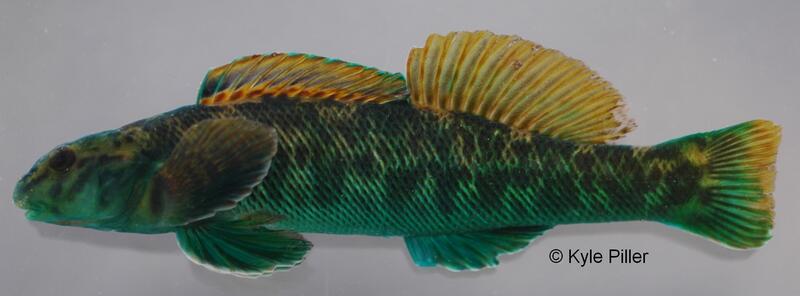







Loading profile. Please wait . . .
Etheostoma gutselli (Hildebrand, 1932)
Tuckasegee Darter





Federal Protection: No US federal protection
State Protection: No Georgia state protection
Global Rank: G3G4
State Rank: S1
Element Locations Tracked in Biotics: Yes
SWAP 2015 Species of Greatest Conservation Need (SGCN): Yes
SWAP 2025 Species of Greatest Conservation Need (SGCN): Yes
2025 SGCN Priority Tier: High Conservation Concern
Element Occurrences (EOs) in Georgia: 3
Habitat Summary for element in Georgia: High gradient creeks and medium-sized rivers
This species has an elongated body nearly as broad as it is deep in advance of the dorsal fin. It has a deep caudle peduncle and a blunt head with eyes placed high and rather close together and large dorsal fins. It’s head, nape, chest and anterior part of the abdomen are devoid of scales. They have dark blotches that look like X’s and W’s on their lower sides that turn green in breeding males. In nuptial males, the spinous dorsal fin has three bands, a basal red-orange, middle green and distal red-orange. A thin blue-green border occurs on the edge of the spinous dorsal fins. The soft dorsal fin has an orange or yellow hue with a red and green band. They can reach a maximum size of five inches.
E.gutselli has recently been differentiated from E. b. newmanii. Both species used to be a part of the Greenside Darter (Etheostoma blenniodes) subspecies group. Evidence shows that the two species (gutselli and newmanii) are maintaining separate evolutionary histories although there is the potential for sympatry. The two species show evidence of past hybridization, but there is no evidence of ongoing hybridization. E. gutselli has fewer lateral blotches than E. b. newmanii and more often has a distinct frenum and prevomerine teeth. E. gutselli also has fewer lateral line and least caudal-peduncle scales. Nuptial male pigmentation also differs between the two species where E. gutselli has a distinct dark spot near the origin of the first dorsal fin, a blue-green belly and reddish-brown vermiculations in the pectoral, pelvic, soft dorsal and caudal fins.
Swift riffle areas with boulder or course rubble substrates in small to moderate riffles in streams above 350 meters elevation.
Juveniles likely consume midge larvae and microcrustacea. Adults consume midge larvae, blackyfly larvae, mayfly larvae, caddisfly larvae and snails.
Spawning likely occurs in early spring. It has been reported in Greenside Darters that spawning is initiated by the females by nudging the males. The male will then follow the female and the female will select a spawning location. Egg release occurs during a typical darter spawning embrace.
This species can be found by kick seining and backpack electrofishing in riffles.
This fish is found in the upper Blue Ridge portions of the Little Tennessee River and upper Pigeon River drainages in Tennessee, Georgia and North Carolina.
This species is fairly protected because it occurs mostly within the Chattahoochee National Forest. However, threats to the national forest include climate change, acid rain, the abundance of roads, southern pine beetle infestations that destroy the canopy and misuse of the forest land by the general public.
| Threat 1 | Threat 2 | Threat 3 | |
|---|---|---|---|
| General Threat | Climate change & severe weather | Pollution | None |
| Specific Threat | None | Agricultural & forestry effluents | None |
This species is considered stable in Georgia.
Places that this fish occur in the National Forests need to remain protected in order for this fish to maintain it’s populations.
Etnier, D.A. and W. D. Starnes. 1993. The Fishes of Tennessee. Univ. Tennessee Press, Knoxville: 468-470.
Hildebrand, S.F., 1932. On a collection of fishes from the Tuckasegee and upper Catawba River basins, North Carolina, with a description of a new darter. J. Elisha Mitchell Sci. Soc. 48: 50–82.
Piller, K. R. and H. L. Bart. 2017. Rediagnosis of the Tuckasegee Darter, Etheostoma gutselli (Hildebrand), a Blue Ridge Endemic. Copeia 105 (3): 569-574.
Piller, K. R., H. L. Bart and D.L. Hurly. 2008. Phylogeography of the greenside darter complex, Etheostoma blennioides (Teleostomi: Percidae): A wide-ranging polytypic taxon. Molecular Phylogenetics & Evolution 46 (3): 974-985. www.tnacifin.com
Shawna Mitchell
S. Mitchell, Feb 2019: Original account